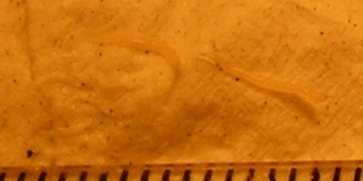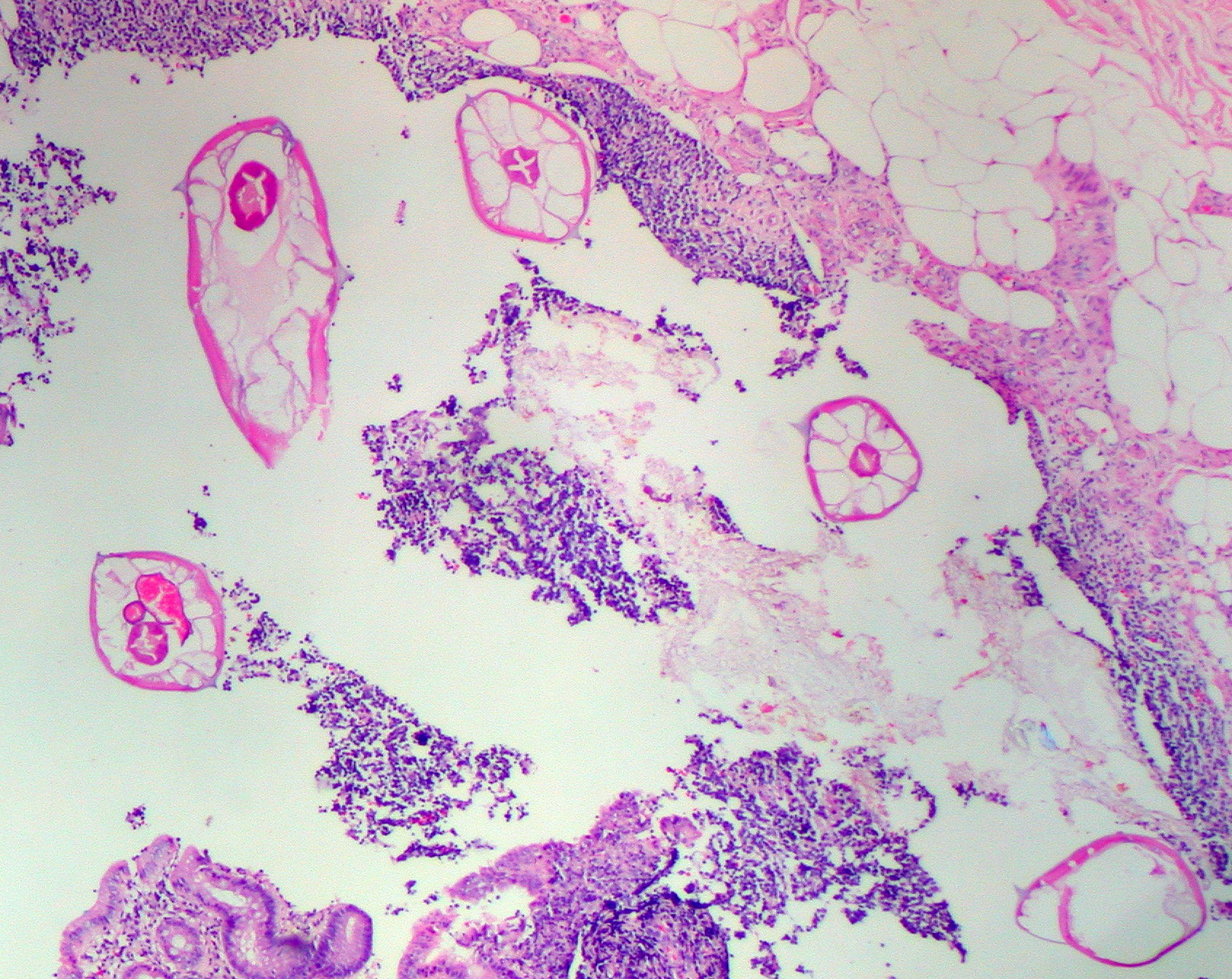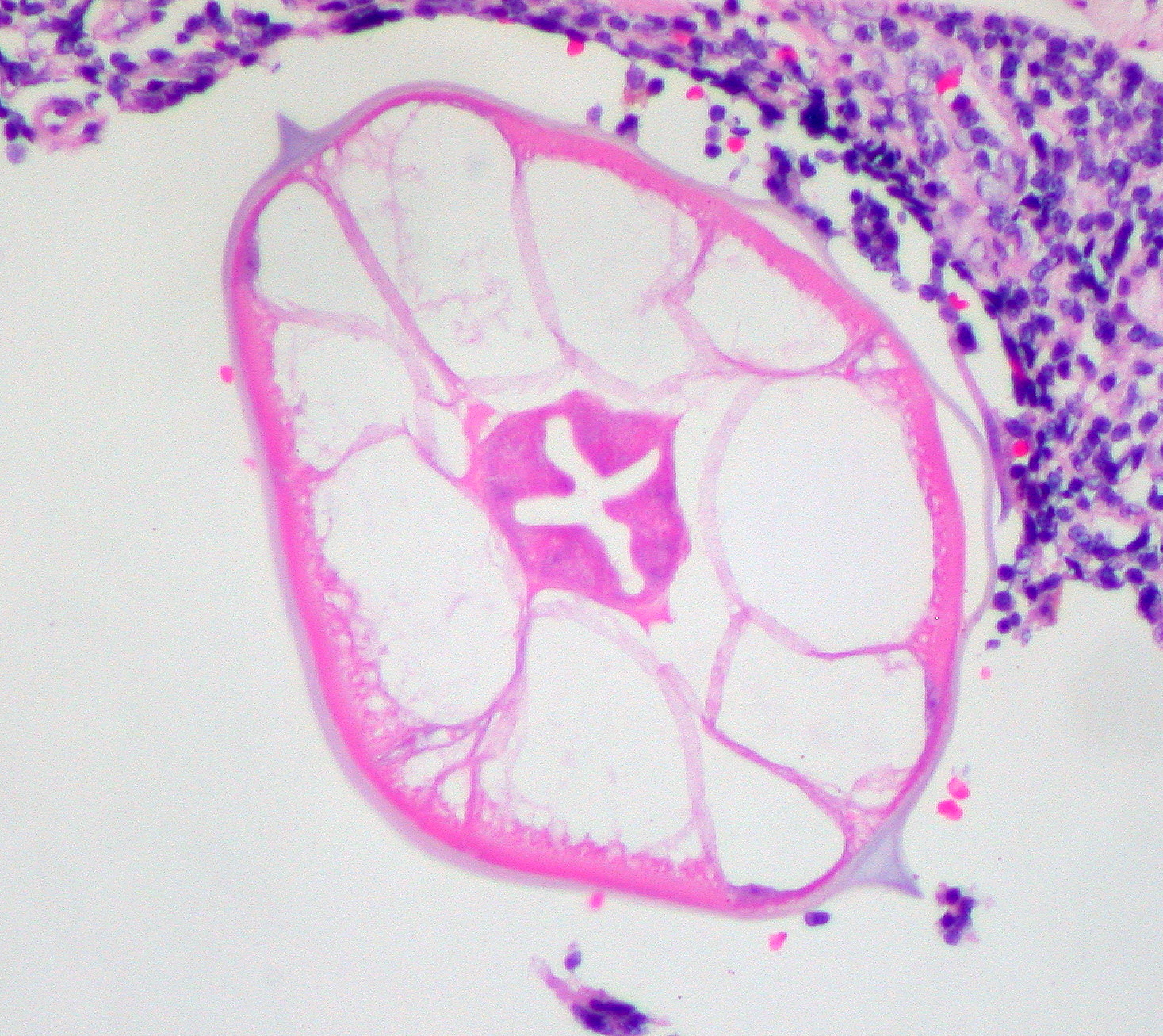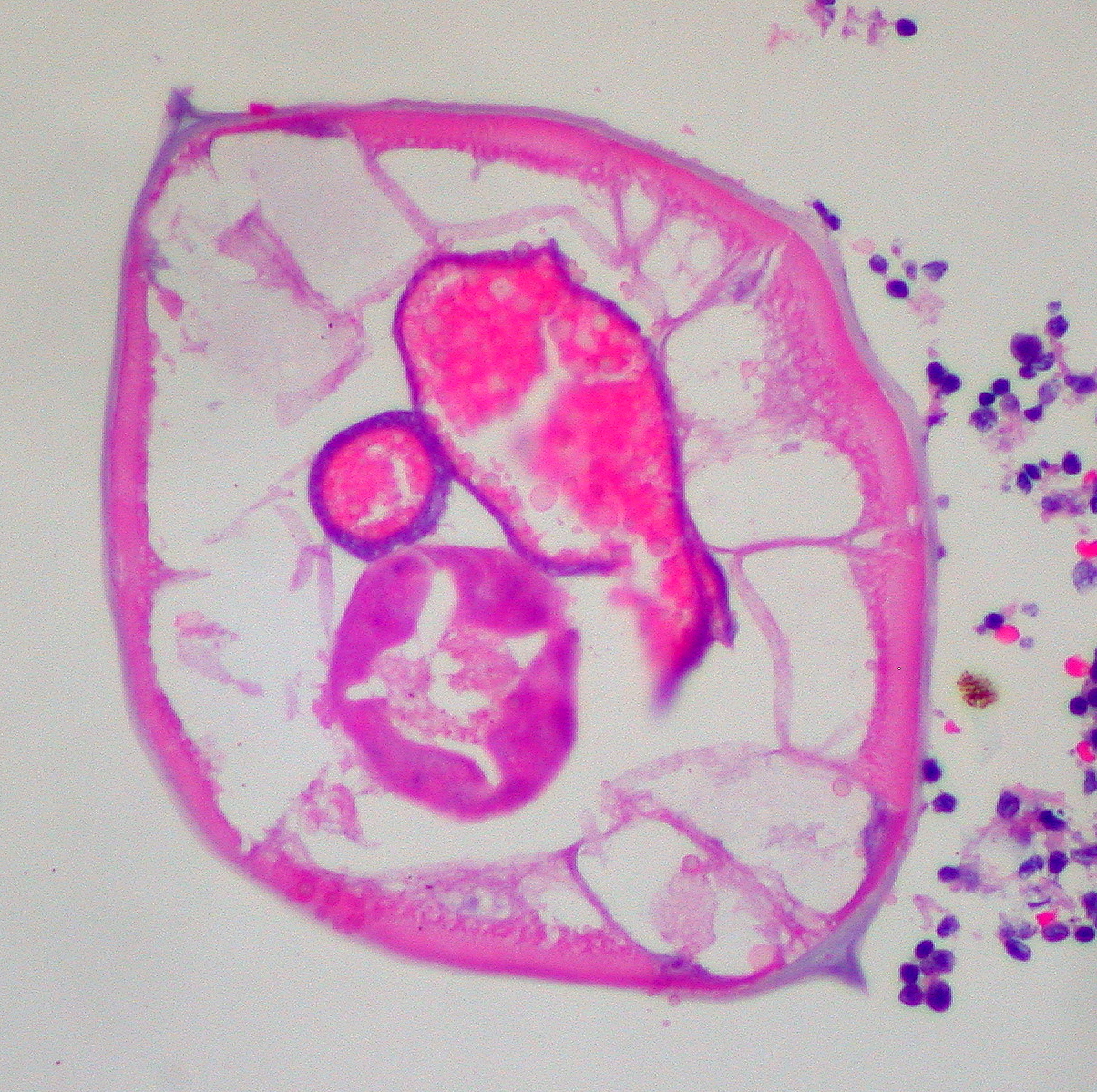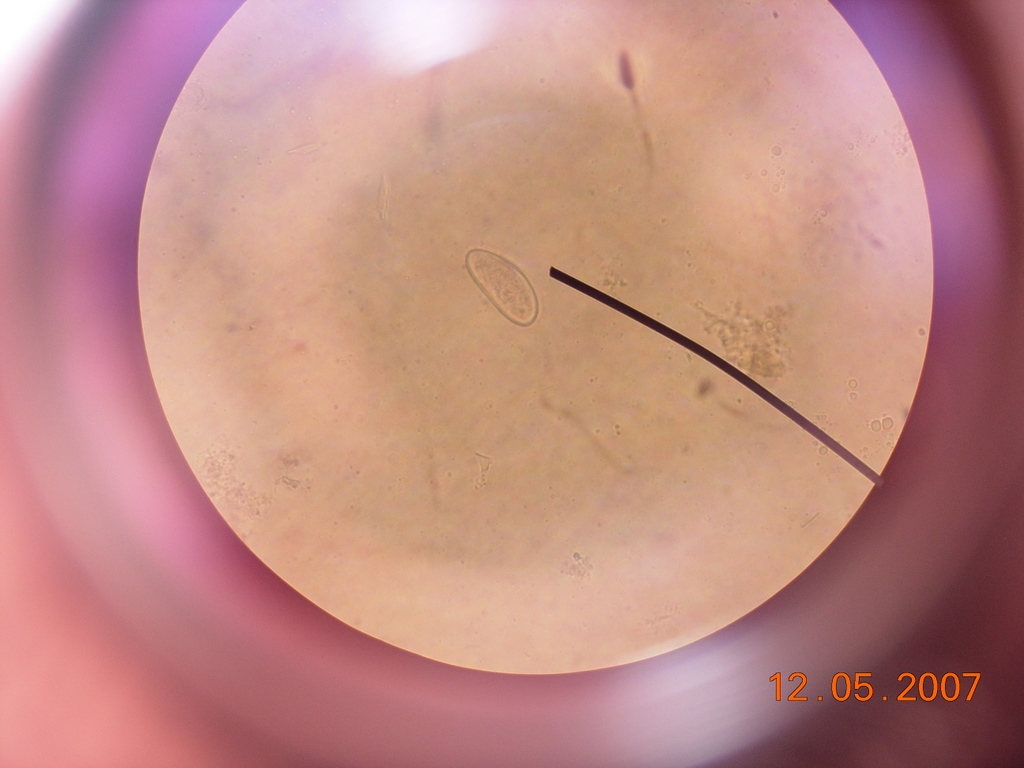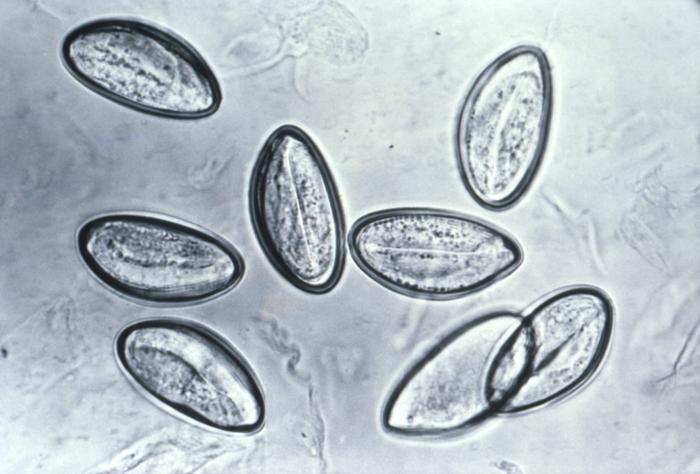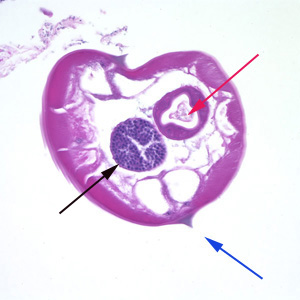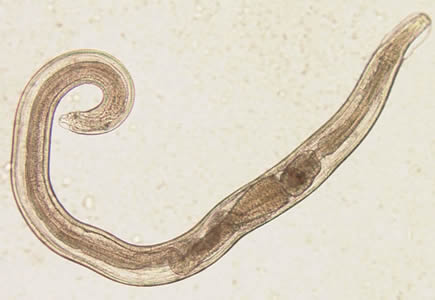Enterobiasis laboratory findings: Difference between revisions
No edit summary |
m (Bot: Removing from Primary care) |
||
| (21 intermediate revisions by 5 users not shown) | |||
| Line 1: | Line 1: | ||
__NOTOC__ | __NOTOC__ | ||
{{Enterobiasis}} | {{Enterobiasis}} | ||
{{CMG}} | {{CMG}} {{AE}} {{MMF}} | ||
==Overview== | ==Overview== | ||
Diagnosis is often made clinically by observing the female worm(s) in the peri-anal region, but can also be made using the [["scotch-tape" test]], in which the sticky side of a strip of [[cellophane]] tape is pressed against the peri-anal skin, then examined under a microscope for pinworm eggs. | Diagnosis of enterobiasis is often made clinically by observing the female worm(s) in the peri-anal region, but can also be made using the [["scotch-tape" test]], in which the sticky side of a strip of [[cellophane]] tape is pressed against the peri-anal skin, then examined under a microscope for pinworm eggs. | ||
==Laboratory Findings== | ==Laboratory Findings== | ||
===Scotch Tape Test=== | ===Scotch Tape Test=== | ||
It is also called Hall or National Institute of Health swab. Sticky side of a strip of [[cellophane]] tape is pressed against the peri-anal skin, then examined under a microscope for pinworm eggs. The test is repeated for five consecutive mornings to increase the sensitivity to 99%. It is done prior to washing or defecation. | It is also called Hall or National Institute of Health swab. Sticky side of a strip of [[cellophane]] tape is pressed against the peri-anal skin, then examined under a microscope for pinworm eggs. The test is repeated for five consecutive mornings to increase the sensitivity to 99%. It is done prior to washing or defecation. | ||
The diagnostic characteristics of egg are: size 50- | The diagnostic characteristics of egg are: size 50-54 µm by 20-27 µm; typical elongated shape, with one convex side and one flattened side and colorless shell.<ref name="pmid21286054">{{cite journal |vauthors=Caldwell JP |title=Pinworms (enterobius vermicularis) |journal=Can Fam Physician |volume=28 |issue= |pages=306–9 |year=1982 |pmid=21286054 |pmc=2306321 |doi= |url=}}</ref><ref name="pmid7959218">{{cite journal |vauthors=Cook GC |title=Enterobius vermicularis infection |journal=Gut |volume=35 |issue=9 |pages=1159–62 |year=1994 |pmid=7959218 |pmc=1375686 |doi= |url=}}</ref> | ||
===Stool analysis=== | ===Stool analysis=== | ||
Stool analysis for ova and parasites is of low diagnostic yield. <ref>{{cite | Stool analysis for [[ova]] and [[parasites]] is of low diagnostic yield. The actual worms may be seen in the host's [[feces]]; however the eggs are invisible to the naked eye.<ref name="pmid21286054">{{cite journal |vauthors=Caldwell JP |title=Pinworms (enterobius vermicularis) |journal=Can Fam Physician |volume=28 |issue= |pages=306–9 |year=1982 |pmid=21286054 |pmc=2306321 |doi= |url=}}</ref> | ||
===Histology=== | ===Histology=== | ||
On [[histology|histologic]] cross-section | On [[histology|histologic]] cross-section [[Alae (anatomy)|alae]] or wings (running the length of the worm) are identifying features of the pinworm (see micrograph).<ref>Diagnostic Findings Enterobiasis. [[Centers for Disease Control and Prevention]]. URL:http://www.dpd.cdc.gov/dpdx/HTML/Enterobiasis.htm. Accessed on: August 6, 2008.</ref> | ||
===Images=== | |||
<gallery> | <gallery> | ||
Image:Threadworm.jpg|Two pinworms, captured on emergence from the anus. Markings are 1 mm apart. | Image:Threadworm.jpg|Two pinworms, captured on emergence from the anus. Markings are 1 mm apart. | ||
| Line 30: | Line 30: | ||
{{#ev:youtube|YNrkWStDdmo}} | {{#ev:youtube|YNrkWStDdmo}} | ||
==References== | ==References== | ||
{{reflist|2}} | {{reflist|2}} | ||
{{WH}} | |||
{{WS}} | |||
[[Category:Disease]] | [[Category:Disease]] | ||
| Line 39: | Line 41: | ||
[[Category:Nematodes]] | [[Category:Nematodes]] | ||
[[Category:Proctology]] | [[Category:Proctology]] | ||
[[Category:Pediatrics]] | |||
[[Category:Emergency medicine]] | |||
[[Category:Up-To-Date]] | |||
[[Category:Infectious disease]] | [[Category:Infectious disease]] | ||
[[Category: | [[Category:Gastroenterology]] | ||
Latest revision as of 21:34, 29 July 2020
|
Enterobiasis Microchapters |
|
Diagnosis |
|---|
|
Treatment |
|
Case Studies |
|
Enterobiasis laboratory findings On the Web |
|
American Roentgen Ray Society Images of Enterobiasis laboratory findings |
|
Risk calculators and risk factors for Enterobiasis laboratory findings |
Editor-In-Chief: C. Michael Gibson, M.S., M.D. [1] Associate Editor(s)-in-Chief: Furqan M M. M.B.B.S[2]
Overview
Diagnosis of enterobiasis is often made clinically by observing the female worm(s) in the peri-anal region, but can also be made using the "scotch-tape" test, in which the sticky side of a strip of cellophane tape is pressed against the peri-anal skin, then examined under a microscope for pinworm eggs.
Laboratory Findings
Scotch Tape Test
It is also called Hall or National Institute of Health swab. Sticky side of a strip of cellophane tape is pressed against the peri-anal skin, then examined under a microscope for pinworm eggs. The test is repeated for five consecutive mornings to increase the sensitivity to 99%. It is done prior to washing or defecation. The diagnostic characteristics of egg are: size 50-54 µm by 20-27 µm; typical elongated shape, with one convex side and one flattened side and colorless shell.[1][2]
Stool analysis
Stool analysis for ova and parasites is of low diagnostic yield. The actual worms may be seen in the host's feces; however the eggs are invisible to the naked eye.[1]
Histology
On histologic cross-section alae or wings (running the length of the worm) are identifying features of the pinworm (see micrograph).[3]
Images
-
Two pinworms, captured on emergence from the anus. Markings are 1 mm apart.
-
Pinworms are sometimes diagnosed incidentally by pathology. Micrograph of pinworms in the appendix. H&E stain.
-
High magnification micrograph of a pinworm in cross-section in the appendix. H&E stain.
-
High magnification micrograph of a pinworm in cross-section in the appendix. H&E stain.
-
Enterobius vermicularis egg under a light microscope.
-
Pinworm eggs are easily seen under a microscope.
-
Pinworms are sometimes diagnosed incidentally by pathology. Micrograph of male pinworm in cross-section. Alae (blue arrow), intestine (red arrow) and testis (black arrow). H&E stain.
-
A pinworm (Enterobius vermicularis).
Videos Showing Pinworm Egg Under Microscope
{{#ev:youtube|YNrkWStDdmo}}
References
- ↑ 1.0 1.1 Caldwell JP (1982). "Pinworms (enterobius vermicularis)". Can Fam Physician. 28: 306–9. PMC 2306321. PMID 21286054.
- ↑ Cook GC (1994). "Enterobius vermicularis infection". Gut. 35 (9): 1159–62. PMC 1375686. PMID 7959218.
- ↑ Diagnostic Findings Enterobiasis. Centers for Disease Control and Prevention. URL:http://www.dpd.cdc.gov/dpdx/HTML/Enterobiasis.htm. Accessed on: August 6, 2008.
